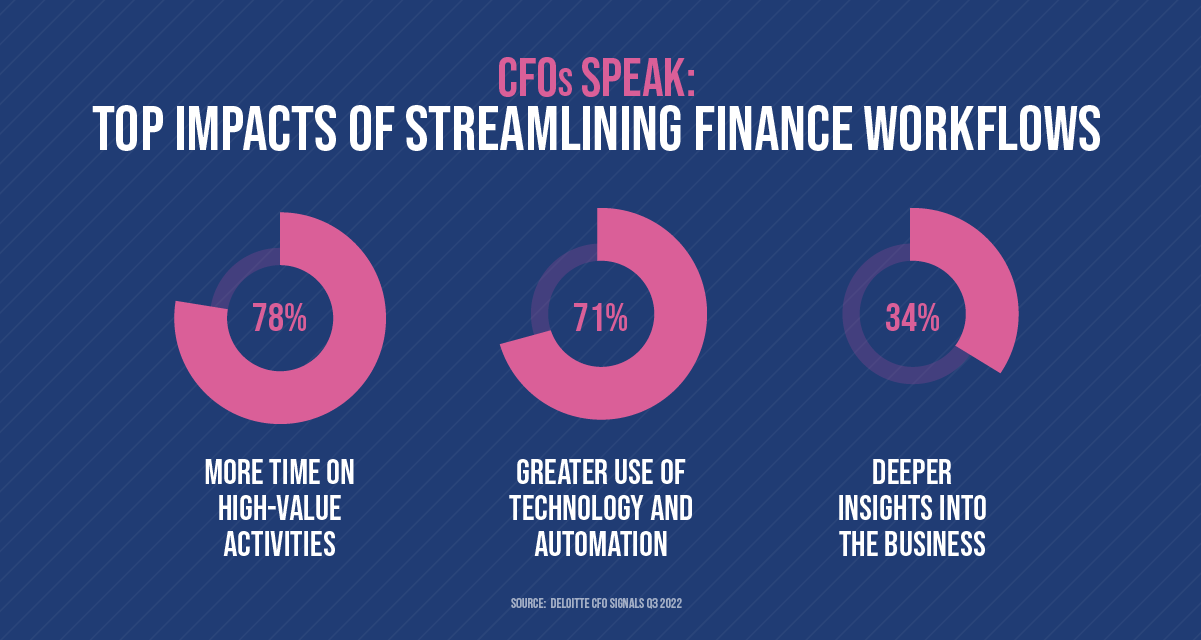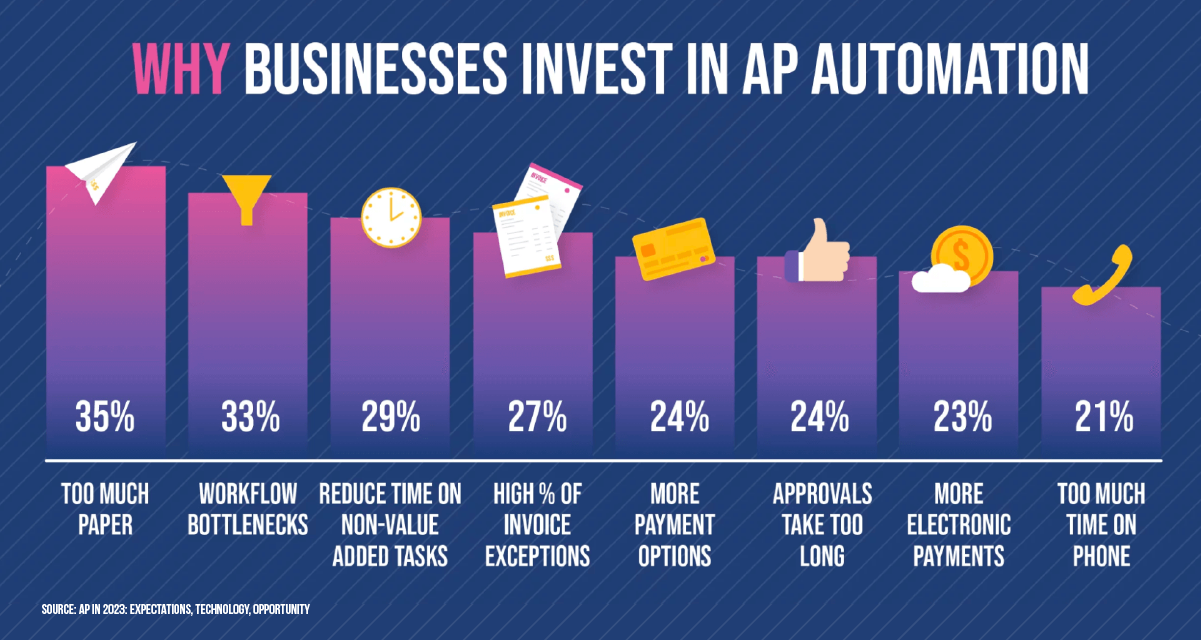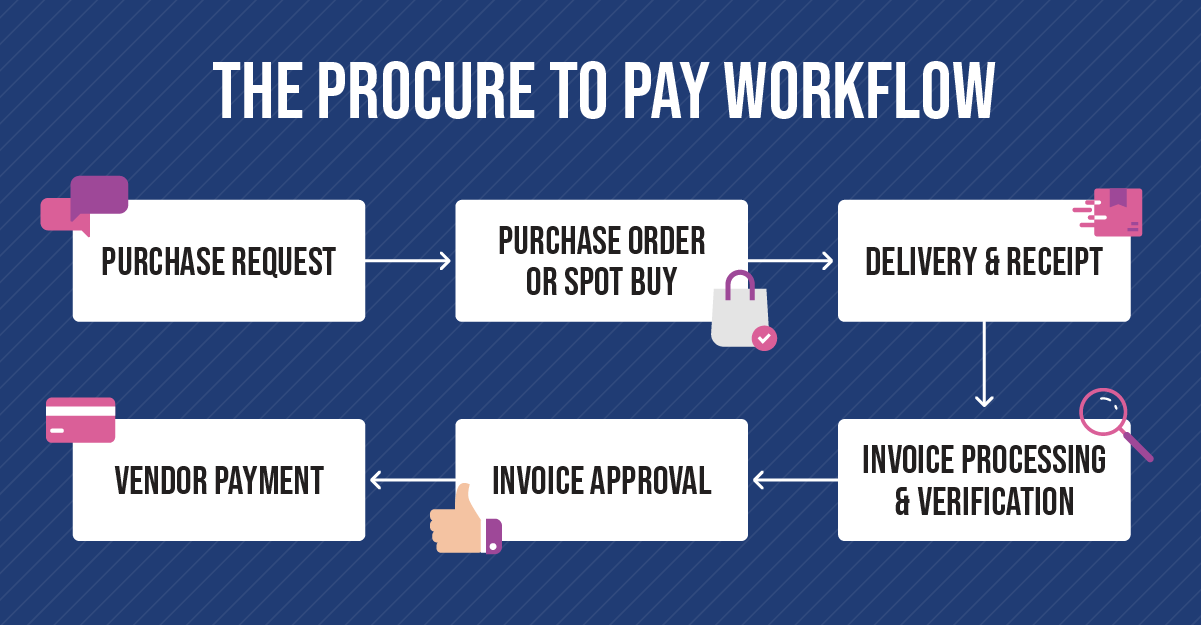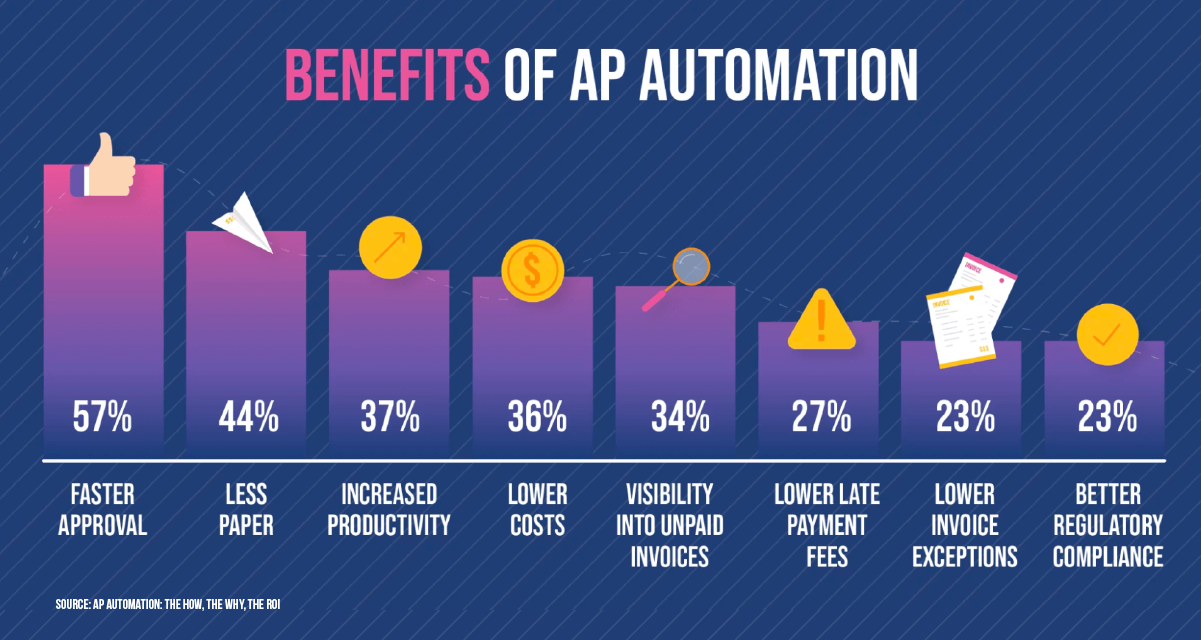AP Transformation – Our Ultimate Guide

Business management, including accounts payable, is undergoing an evolutionary change. Digital technologies and artificial intelligence are streamlining business processes and allowing businesses to achieve significant efficiency gains and to drive growth. At the same time, those same technologies are enabling CFOs to take on a more strategic role – turning functions like accounts payable into powerful sources of insight that drive business strategy and increase profitability.
The challenge facing CFOs is interpreting the transformative power of AP process automation for their business and planning accordingly. According to a 2022 survey by PYMNTS.com, 43% of CFOs say automation is about greater efficiency and cost savings, while 57% say it’s about doing things in new and better ways. One thing is sure: AP is coming out of the back office, and finance leaders need to understand the changes transforming their business.
In this article, we help you navigate the journey by exploring how AP automation can transform specific AP operations. We’ll discuss the benefits of implementing AP automation for your business and provide recommendations for transforming your company’s AP processes.
Inside the Accounts Payable Transformation
CFOs across all industries are embracing digital transformation – and seeing results.
In CFO Signals 3Q 2022, Deloitte reported on how CFOs were transforming their organizations’ finance functions. About half (49%) of CFOs surveyed said they drove digital transformation & automation in 2022, 33% said they leveraged technology or implemented an ERP transformation, and 22% said they improved or standardized finance processes.

Deloitte reported that 78% of CFOs said the impact of the transformation was that their teams spent more time on high-value activities, 71% made greater use of technology and automation, and 34% said they got deeper insights into their business.
The Growing Strategic Value of Accounts Payable
In Stampli’s 2023 survey of finance leaders, 63% said they expected the responsibilities of their AP department to grow. The same survey documented why businesses invest in AP automation, as you’ll see below.

The drivers for this growth are complex. One major factor is the increasing volume and complexity of vendor invoices – 80% of leaders said they expected an increase in the volume of invoices their businesses receive, and 55% said the complexity of invoices was also increasing. Since most AP departments (57%) expected staffing to remain the same, AP teams must handle the increased volume and complexity without adding resources.
At the same time, 65% of leaders said the strategic role of their AP department was increasing year-over-year as well. AP automation solutions provide CFOs with real-time data and analytics, allowing leaders to anticipate, forecast, and plan for future expenditures, manage cash flow, and to make informed decisions. With better and more strategic cash management, businesses can access funding to invest in new growth, making investing in AP automation an intelligent choice.
Let’s look at some areas where AP automation gives the best ROI.
Where to Begin: AP Functions That Can Be Automated
Accounts payable automation can streamline and optimize most processes in the procure-to-pay (P2P) workflow. By replacing inefficient, manual paper-based processes, automation speeds up processing time and reduces errors and fraud.
AP automation also provides accurate, real-time visibility into transaction data and workflows, giving CFOs and controllers a high level of control over P2P. Most AP automation platforms also integrate with ERP and accounting systems to improve collaboration across departments and provide a single source of accurate data to the whole company.

AP processes that can be automated fall under three broad categories: Vendor Management, Invoice Processing, and Spend Management.
Vendor Management
Vendor management encompasses supply chain operations like vendor onboarding, ordering, and shipping. Many AP platforms provide a vendor portal that allows vendors to communicate with AP teams and stakeholders, check the status of payments, and ask questions.
Some AP solutions, such as Stampli, provide more advanced vendor management capabilities, including automated vendor onboarding and document management, to ensure critical vendor information is available to everyone in the P2P workflow.
Implementing AP automation also improves supplier relationships by reducing late and missed payments – which keeps vendors happy.
Invoice Processing
Invoice processing involves receiving, entering, coding, and verifying vendor invoices. Typically, these manual processes are time-consuming for AP departments, resulting in late payments and errors.
AP automation streamlines invoice processing by replacing manual entry and coding with automated invoice entry, using OCR scanning and a central email address to receive invoices electronically. Automation platforms also perform three-way real-time matching between invoices, purchase orders, and receipts, flagging AP staff if there’s a discrepancy.
Automation also streamlines invoice approval workflows to ensure approvers have all the information they need to approve invoices quickly – speeding up this common bottleneck and ensuring vendors get paid on time.
Spend Management
In AP in 2023: Expectations, Technology, Opportunity, Stampli reported that 72% of businesses expect to increase the use of electronic payments, with almost one-third (27%) expecting the increase to be “significant.” This represents a major shift in how businesses manage expenditures. Many AP automation providers have responded to this shift by including payment and expense management capabilities in their offerings.
AP automation can streamline both vendor payments and expense workflows. Here are some examples:
- Payment management solutions optimize the vendor payment process by replacing often-disconnected manual payment workflows with a single payments platform
- Expense management solutions simplify the expense reporting and employee reimbursement process with a single end-to-end solution
- Many AP automation vendors also offer payment cards or virtual cards to give businesses more flexibility in how they pay vendors and employee expenses
Most AP automation platforms integrate with ERP and accounting systems to ensure transactions data is recorded accurately. By providing access to real-time data, automation platforms enable businesses to perform AP audits and reconciliations in real-time, whenever needed.
Based on workflow optimization alone, AP transformation provides clear, direct business benefits. Read on to learn more about those benefits and a few indirect benefits you may have yet to consider.
The Benefits of AP Automation
In a recent webinar, Ernie Humphreys, CEO and COO of Treasury Webinars, explored the direct and indirect benefits of implementing accounts payable automation as reported by CFOs responding to an industry survey. One of the survey’s goals was to understand the real-world ROI businesses saw from AP automation.
Not surprisingly, the top two benefits were faster approval of invoices and a reduction in the volume of paper invoices – significant direct benefits with real-world metrics supporting the case for investing in automation. The survey also revealed several other benefits from AP transformation, some of which can provide a significant strategic advantage to your business

Reduced Invoice Processing Costs
AP automation significantly improves invoice processing efficiency, letting your business improve cash flow, reduce labor costs, and reduce late payment fees. Automation also reduces the amount of paper your business must handle and store. Reducing paper is another source of savings and a major efficiency gain, as employees no longer need to file paper records or search through files to locate a lost document.
The efficiency gains can be substantial. One study found that implementing automated invoice processing can raise the number of invoices a single AP employee can process from 6,082 to 23,333 invoices per year.
Greater Oversight and Control of Procure-to-Pay Processes
AP automation platforms automatically collect invoice data and upload it to an ERP or accounting system in real-time without manual data entry. Sharing the data across the business ensures that the CFO, Controller, and accounting staff can access the data to resolve errors and exceptions and perform analyses as needed. CFOs can also access real-time KPIs and insights through a visual dashboard to identify trends, run forecasts, and make informed decisions.
Simplify Operations
Automated document capture and routing ensures that invoices, receipts, purchase orders, contracts, and vendor documents are never lost, misrouted, or stuck in an inbox. AP platforms centralize communications and document management and streamline workflows such as approvals to ensure employees have the right documents and information when needed.
Here’s an example: When an invoice is ready for approval, the system notifies approvers, sending reminders if necessary. Once the invoice is approved, the system automatically routes everything to finance for payment. Vendors can access the system through a portal to check the payment status, ask questions, and provide necessary information.
The system also automatically detects and flags errors, signs of fraud, or duplicate payments or invoices, saving the time it would take AP staff to track down and correct the discrepancy manually.
Easy Implementation & ERP Integration
Most AP automation platforms integrate with ERPs and accounting systems. The best AP platforms make the process seamless and fast. A seamless integration means the AP platform can post data straight through to the ERP with minimal intervention. Automatic data synchronization ensures that the ERP serves as a single source of truth for accounts payable data and that both platforms have a consistent audit trail.
Improve Audit Accuracy
It can be difficult to maintain and enforce controls such as the segregation of duties if a business still uses manual accounts payable processes. AP automation platforms automatically enforce internal controls to reduce errors, prevent fraud, and to mitigate risk. Also, automation platforms track and record documents, transaction data, and communications in a central location, providing a complete audit trail and making audit AP processes easier.
To achieve these benefits, it’s important to fully understand the value AP automation can bring to your business.
Recommendations for Action for Digital Transformation
Not all AP automation solutions or businesses are created the same. To determine the best path to AP transformation, you must dig into your current operations, future needs, and strategic goals. Here are some recommendations for action that you can take:
Communication Is Everything
Accounts payable is complex, and the stakes are high – if implementation goes wrong, it can have serious consequences for your business. Find an AP solution that puts communication and collaboration first – backed by excellent support and troubleshooting and a proven track record of excellent customer service.
Understand the Procurement to Payment Workflow
Take a deep (and honest) dive into your entire P2P process at least once a year. Transformation is a continuous process that requires continuous commitment. Regularly review your processes to determine what’s working, what isn’t, and where the bottlenecks are.
Choose an AP Partner That Supports Your Strategy
Ensure that you get the full return on your investment in AP automation by choosing a partner that can offer insights on how their solution can further increase your ROI and support your business strategy.
Understand the True ROI of AP Automation
Ensure that your business leaders understand the benefits your company wants to realize from AP automation, and then find a solution provider that fits your needs well.
Look Into Integrations to Realize Better ROI
The quality of the integration between your potential AP automation platform and your existing ERP and accounting systems is crucial to success. Look for cloud-based AP solutions that support your current systems and require minimal changes to your IT infrastructure and existing P2P processes.
Choose a Flexible AP Automation Partner
Consider any potential AP provider’s flexibility and ability to maintain your current systems and P2P workflows, especially if they’re complex. You shouldn’t need to make sweeping changes to your existing investments to accommodate a new partner. Instead, look for a partner who can adapt and grow their solution to meet your company’s evolving needs.
Use an Implementation Roadmap
Find an easy-to-follow guide to choosing and implementing an accounts payable solution provider to set goals, understand the steps, and anticipate and mitigate any obstacles.
Stampli: The Logical Choice for AP Transformation
Stampli is the leading AP automation solution and the best way to transform your P2P workflows and maximize ROI. With a proven track record of excellence in Delivering Results, Customer Relationships, Implementation, and Usability, Stampli is your ideal strategic partner – with a scalable and flexible AP automation solution that meets your current and future business needs.
Stampli offers a no-code implementation that takes weeks, not months, and seamlessly integrates with major ERP systems and accounting platforms. You’ll immediately see the impact of AP automation on your bottom line.
Take the first step to AP transformation today. Contact Stampli to arrange a free demo.
